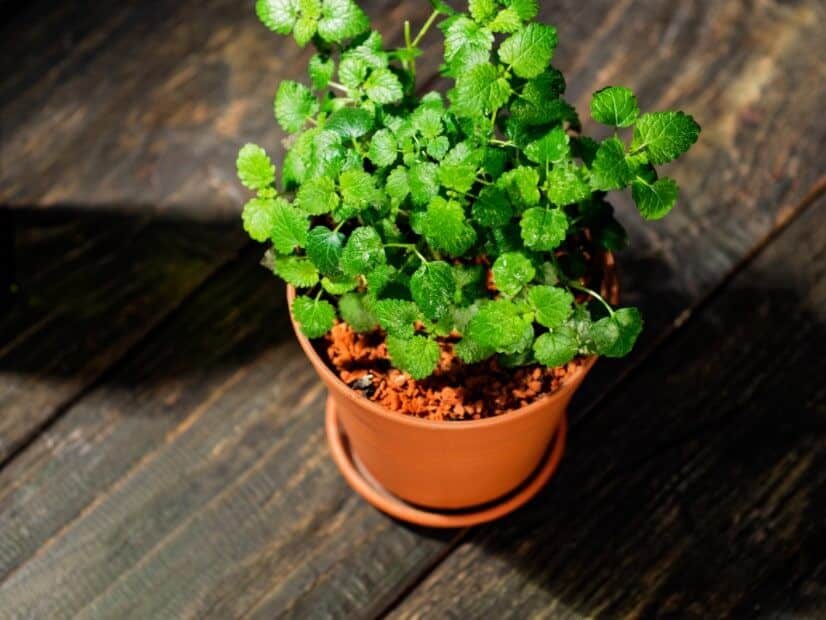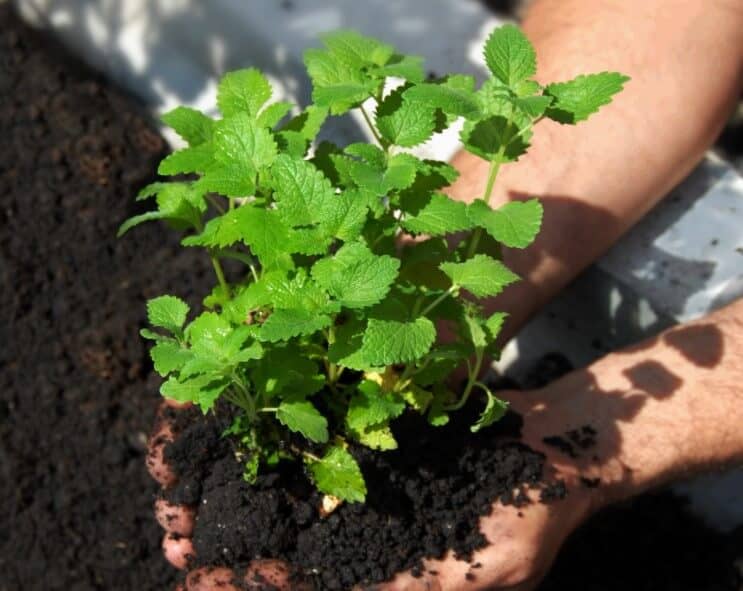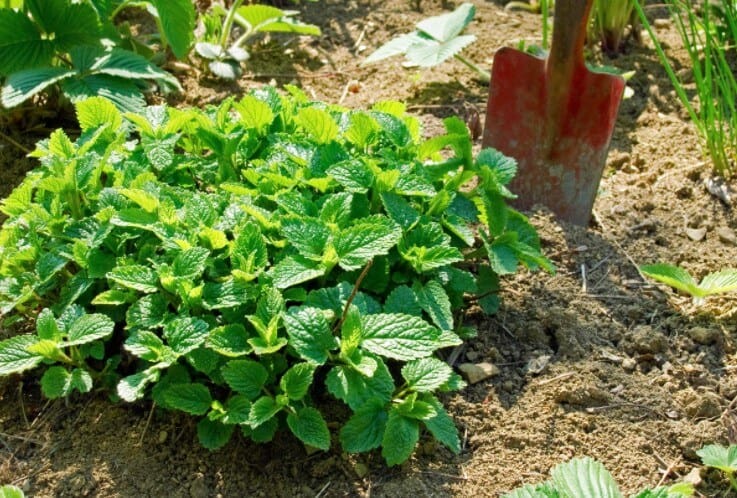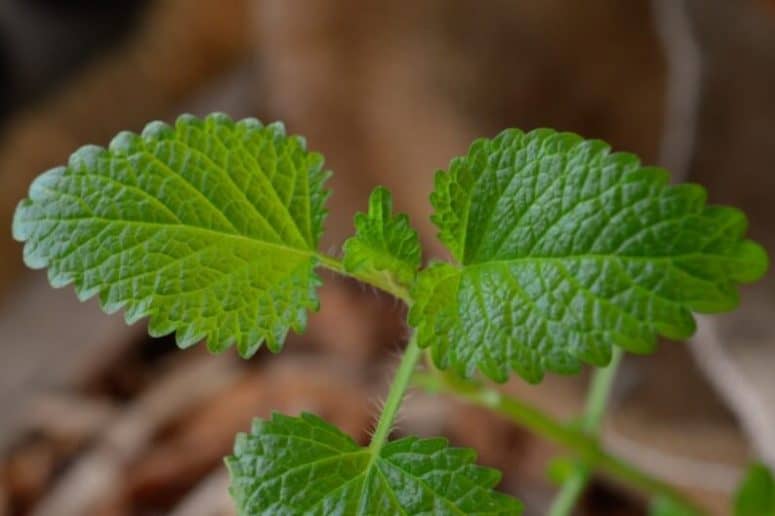How to Grow Lemon Balm At Home (A Beginner Guide)

Lemon Balm (Melissa officinalis), also known as Sweet Melissa, is a herb plant that belongs to the mint family. What’s unique about lemon balm is that it has a trace of lemon scent in its leaves.
The leaves are oval and somehow like heart shape with bright green color, the best greeny you want to see in plants.
In terms of visual attraction, lemon balm blooms tiny pink flowers on top, which does attract not only our attention but also mutual insects like bees and butterflies.
Usually, people plant lemon balm for culinary purposes. The fresh lemony scent on its leaves and the cool sensation from its mint flavor are often used in cool or hot drinks.
What’s even better about lemon balm is that this herb could replace the actual lemon flavor in the dish. You can even add it to your fruit salad, meats, and poultry products.
However, the freshness from lemon balm is not just attractive for culinary purposes. Some people seek the health benefits of lemon balm as well.
Lemon balm has traditionally been used as an ingredient to relieve stress, reduce anxiety, treat indigestion, gas, and bloating, and even help sleep disorders such as insomnia.
Planting lemon balm is one of the easiest herb plantings you would have. The benefit and usage of lemon balm in culinary and health are going to worth your green thumb.
Besides, lemon balm in groceries could be quite pricey. You can save a lot of budget by growing your lemon balm. Now here is the ultimate guide on how to grow thyme at home.
How to Grow Lemon Balm
There are some different ways of growing lemon balm at home. You can grow it from seed, cuttings, layerings, or divisions.
Growing lemon balm from seeds will require germination, which will happen more or less in 14 days. Before that, you’re going to have to chill the seed for at least seven days.
Therefore, many people sow their seeds in the fall for their spring plants. You can root the stems in rooting hormone and plant them in organic potting soil for cuttings.
The lemon balm itself is a self-seeding plant, where it sows the seeds by itself to grow even more lemon balm plants. This could happen in some weeks. Planting lemon balm from seeds is possible, and the germination could potentially be successful.
But if you want to have a more comfortable and faster way as a beginner, you’d better grow lemon balm from cutting.
Indoors or Outdoors?
Well, lemon balm is a versatile kind of herb. When you plant it outdoor, lemon balm could invade your garden.
Lemon balm is self-seeding and sows its seeds all over the place as pone bush grows very well. Lemon balm tends to grow very fast that it is normal to see a lemon balm grows two foot tall.
Therefore, many people decide to grow their lemon balm in a container, either indoor or outdoor, to prevent lemon balm’s uncontrolled growth.
Finally, notice that lemon balm growth can be controlled by planting it in the container; it is okay to grow lemon balm indoor or outdoor.
It’s best to plant herbs outdoor, though. But if you give proper care, it would not be an issue to grow it indoors.
Soil
Soil is one of the essential elements of growing plants. As for lemon balm, it loves well-drained soil with a little sandy texture. It is okay to have a bit dense or moist soil for your lemon balm, but you should add more sand or drier soil to make it more brittle.
Another thing to be your attention is that the soil’s pH should be from neutral to acidic (between 6.7 to 7.3). That way, you can make the best environment for lemon balm.
Like most herbs, lemon balm hates to be overwatered and waterlogged. Therefore, be mindful of having containers with ample drainage like terracotta, for instance. The drainage hole could prevent the soil overwatered and avoid root rot as well.
Light
Most herbs like full sun exposure, and so does lemon balm. Lemon balm loves full sun, either indoor or outdoor. However, there are some slight differences between the lights needed indoor and outdoor.
Outdoor lemon balm can tolerate some shades in a sunny garden, but not indoor. Indoor lemon balm should be given just ample sunlight for around five to six hours a day.
Place the container near the window with the light access. Rotate the plant periodically to provide them with even sunlight exposure.
Water
Remember that lemon balm is more okay to be less-watered rather than overwatered. Lemon balm, like most herbs, could recover very quickly from drought. But it would die very fast or bloom flowers once it’s overwatered.
Water your lemon balm plant very gently; never let your watering saturates. Finally, water your lemon balm only when the top inches of the soil has completely dried.
Temperature
When it comes to temperature, lemon balm could tolerate up to -20 Celcius degrees. So, it is okay to leave it outdoor in winter.
However, preparing it to mulch planted before winter is very recommended, as mulch will keep the area warmer.
Meanwhile, for indoor planting, be mindful not to put the container near the air that is too cold or too hot. Never place the lemon balm in front of the air conditioner, or maybe a radiator that produces heat around.
Fertilizer
You can fertilize it with a liquid fertilizer every couple of weeks for more excellent quality lemon balm. However, fertilizing, especially with chemical liquid, could decrease the delicacy and the taste of the herbs.
Therefore, you might not want to fertilize lemon balm if you plant it for cooking or culinary purposes. With good soil, water, and light care, your lemon balm is going to grow just fine.
Harvesting
People have different purposes for planting lemon balm. If you do it for culinary or cooking purposes, you should harvest the lemon balm before it bolts (blooming flowers).
Once the beautiful flowers start to bloom from your lemon balm, the taste of the leaves is going to be bitter. You’re not going to catch that rich lemony flavor from lemon balm anymore.
Therefore, harvest your lemon balm by cutting the stems and the leaves once the plant establishes new growth. Take it just around 1/4 part of the whole plants’ bush. That would be a lot of fresh lemon balms.
Troubleshooting the Pest
Yes, lemon balm attracts bees and butterflies. However, lemon balm has no serious problems with insects, though. Instead, lemon balm is going to have issues with powdery mildew.
Powdery mildew could kill your lemon balm. You can prevent that from happening by separating it from other herbs, knowing that both have a different soil characterization. Make sure your lemon balm plant has good air circulation.
When powdery mildew happens, you can remove the infected leaves and treat the whole stems with a fungicide to begin with.
Conclusion
Lemon balm is very versatile to be planted indoor or outdoor, as long as it doesn’t get too hot or too cold from direct air exposure.
Like most herbs, lemon balm hates to overwater. Therefore well-drained and sandy soil match lemon balm well. A correct method of watering and managing the soil could also prevent powdery mildew.
As for the lights, indoor lemon balm needs ample sunlight every single day. You’re going to need full sunlight for the outdoor lemon balms because lemon balm could tolerate some shady places outdoor.


